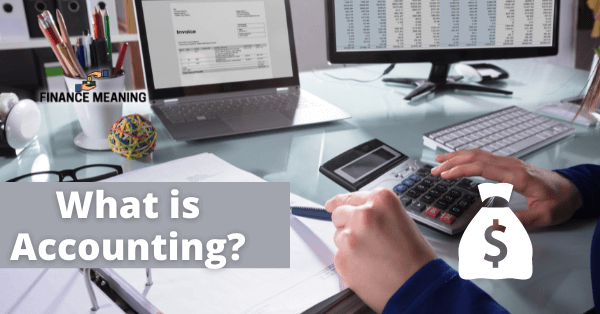What is accounting? In the simplest form, accounting is a business language. It provides the financial information a business needs to determine if it needs to:
- Expand operations
- Purchase new equipment, business, or facilities
- Review new business opportunities
- Invest
Apart from providing financial information, businesses use the system to record business transactions, track them, and prepare financial reports. Accounting is a broad term explaining a range of activities usually summarized into an accounting cycle.
Note bookkeeping is different from accounting. Bookkeeping is a subset of accounting that involves the mechanical process of recording routine economic activities. On the other hand, accounting includes bookkeeping but is more detailed as it analyzes and interprets that data to prepare financial statements. The next part provides an in-depth overview of what is accounting.
How Accounting Works
Knowing the accounting cycle is critical to understanding what is accounting and how it works. It is derived from the American Accounting Association, which defines accounting as the process of measuring, identifying, and communicating financial information to enable users to make informed decisions. The data is primarily stated in monetary terms and is summarized in an eight-step process- the accounting cycle. It entails:
Step 1: Identifying Transactions
The accountant starts by identifying those transactions that comprise the event. It can be a sale, purchase, payment to a vendor, and so on.
Step 2: Record the Transactions
MEDICARE STARTING AGE AND HOW CAN YOU ENROLL FOR IT?
After identifying the transactions, they are recorded in a journal according to the double-entry accounting rule. The entries must be backed by evidence which can be in the form of a receipt, invoice, completion of an economic event, or recognition of a sale.
Step 3: Post the Entries in a Ledger
After the transaction is recorded, it’s posted in a general ledger which details all accounting activities by account (assets, expenses, liabilities, and revenues). The ledger has all the information required to prepare a company’s financial statements (statements of financial position and income statement).
Step 4: Prepare an Unadjusted Trial Balance
The accountant then prepares an unadjusted trial balance. It lists all the balances in the general ledger at the end of the reporting period before preparing financial statements. The general rule of the thumb states that total debits must be equal to total credits.
Step 5: Prepare a Worksheet
The worksheet is used for making adjustments in case the debits aren’t equal to the credits.
Step 6: Making Adjusting Entries
The accountant must make adjusting entries at the end of the period before preparing financial statements. They result from the adjustments made on the worksheet and correct mistakes made during the accounting period.
Step 7: Preparing the Financial Statement
An adjusted trial balance is then prepared, followed by formal financial statements, i.e., the balance sheet, income statement, and cash flow statement.
Step 8: Closing the Books
At the end of the period, the business closes temporary accounts, including the revenue and expenses accounts. Net income is transferred to a statement of equity to adjust the retained earnings balance. Lastly, the accountant prepares a post-closing trial balance to ensure debits and credits are equal before beginning a fresh accounting cycle.
Today, there are software to make the entire process easy. It’s also important to understand the role of what is accounting in business:
Record Business Transactions
Accounting is the essence of setting up an accounting system in any organization. It helps businesses keep systematic records of financial information. Also, consistent and accurate records enable users to assess a company’s performance over some time.
Helps Plan for Growth
Accounting information is pivotal to the preparation of financial statements used in assessing a company’s growth. It’s easy to fall back on metrics like sales growth as a measure for business growth.
However, such a metric provides a superficial outlook about a company’s financial position. You want to look at other metrics like gross profit margin, return on sales, current ratio, and others to evaluate its financial position. Accounting provides all such information.
Ensure Efficient Use of Resources
DIFFERENCE BETWEEN A CASHIER’S CHECK VS. MONEY ORDER
Firms use accounting data to conduct an internal analysis of their operations. The analysis helps the firm identify the resources committed in specific functions and their outcomes. Managers also use this information to analyze past behavior and identify areas that need improvement.
Communicate Results
Accounting information communicates results to internal and external users. External users primarily rely on accounting information to determine a company’s credibility. For example, investors who want to purchase a company’s shares evaluate profitability ratios. On the other hand, lenders analyze liquidity and efficiency ratios to determine their ability to repay debt.
File Financial Statements
Listed companies are required to file financial statements with the Registrar of Companies and the stock exchange. The statements play a critical role when filing taxes with the IRS, and accounting provides all such information.
Create Budgets and Make Future Projections
Accounting is pivotal to the preparation of a company’s short and long-term budgets. This information helps business owners orient the firm to more profitable operations. Also, the owners are keen to track expenses and profits based on historical accounting data. Such financial data is more appropriate when provided by well-structured accounting processes.
Meet Legal Requirements
Proper accounting ensures accurate reporting of a company’s assets and liabilities. Tax authorities like the Internal Revenue Service rely on standardized financial statements to assess a company’s gross revenue and net income. Setting up an accounting system ensures the financial statements are prepared accurately and legally reported.
What is Accounting: Accounting Types
Accounting is a dynamic profession that constantly adapts to users’ needs. Over the years, what is accounting has branched out to different types due to the varying business transactions. For example, a business’s internal transactions are different from external ones.
Thus a business prepares separate financial statements for each. Management accounting, for example, generates reports for the company’s internal users. Conversely, financial accounting involves the preparation of statements for external use.
Also, accounting differs based on the objective. That’s why there are branches like tax accounting and cost accounting. The latter deals in determining the cost of products, while tax accounting helps compute a company’s income tax.
What is Managerial Accounting?
This form of accounting provides internal users with information required to make company decisions. It involves budgeting and forecasting, financial analysis, and cost analysis. The premise for this branch is to meet management needs, not comply with the GAAP.
As such, the information may range from broad, long-range planning data to a detailed explanation of why actual costs vary from estimates. Also, managerial accounting is more concerned about forward-looking projections, not historical recording. For example, when a company decides to buy a part instead of manufacturing it in-house, such a decision is based on managerial accounting information.
2 EASY STEPS: HOW TO CALCULATE OPPORTUNITY COST FORMULA?
What is Financial Accounting?
It is the systematic method of recording business transactions based on accounting principles. Its primary objective is to calculate a profit or loss and provide an accurate outlook of its financial position. Financial accounting looks at past performance and not the future as in managerial accounting. Statements prepared using financial accounting principles include:
- Income statements
- The trial balance
- The statement of financial position
- Statement of changes in equity
What is Tax Accounting?
This branch helps businesses follow the set tax rules. It involves tax preparation and planning, determining income tax, and identifying ways to minimize tax legally. Note there’s a big difference between tax planning and tax evasion.
Tax planning means looking for ways to reduce tax liability within legal boundaries. Conversely, tax evasion means engaging in illegal practices that help avoid paying tax. Tax accounting also involves providing consultancy services regarding tax effects on different business aspects.
What is Credit Accounting?
This branch deals in the management of a company’s accounts receivables. It involves identifying customers who are late in making payment, defaulted payments and guarding against risks of extending credit. Late payment and defaults can harm the business’s financial health.
The credit accountant is tasked with establishing strategic credit management practices and preparing the relevant documentation concerning debt collection. Examples of objectives the professional can establish for strategic credit management include:
- Identifying the average days’ sales outstanding in the industry
- Develop policies to minimize the amount of bad debts
- Compare the company’s results with those of industry peers
- Developing strategies to reduce the Days Sales Outstanding (number of days invoices go unpaid)
What is Cost Accounting?
This branch is a subset of management accounting because managers use its reports to make decisions. Cost accounting involves recording, presenting, and analyzing manufacturing costs.
The premise is to furnish management with important information such as the break-even units, the units required to achieve a target income, etc. Cost accountants also analyze actual costs versus budgets to determine the appropriate courses of action regarding a company’s cost management.
Without a doubt, accounting is the language of business. Its ability to convert raw financial data into analytical information users can rely on to make informed decisions remains unmatched. It explains the adage by Jonathan Glancy, ‘The pen is mightier than the sword but is no match for an accountant.




